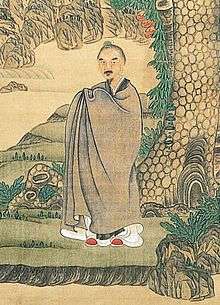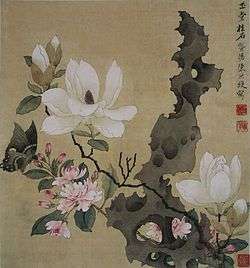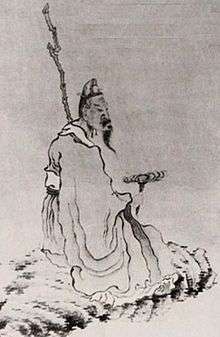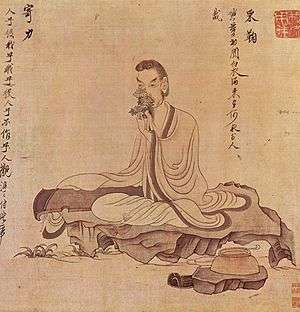Chen Hongshou
| Chen Hongshou | |||||||||
 Self portrait of Chen Hongshou, 1635 | |||||||||
| Traditional Chinese | 陳洪綬 | ||||||||
|---|---|---|---|---|---|---|---|---|---|
| Simplified Chinese | 陈洪绶 | ||||||||
| |||||||||
Chen Hongshou (1598–1652), formerly romanized as Ch'en Hung-shou, was a Chinese painter of the late Ming dynasty.
Life
Chen was born in Zhuji, Zhejiang province in 1598, during the Ming dynasty. His courtesy name was Zhanghou (章侯), and his pseudonyms were Laolian (老莲), Fuchi (弗迟), Yunmenseng (云门僧), Huichi (悔迟), Chiheshang (迟和尚) and Huiseng (悔僧).[1] He once trained under Lan Ying, and was skilled in painting peculiar human figures, landscapes, flower-and-bird. He utilized plump, profound brushwork and precise color, creating a unique style. He always painted illustrations and made tapestry portraits. His two masterpieces," Shui Hu Ye Zi" (水浒叶子) and "Bo Gu Ye Zi", were the rare examples among the Ming and the Qing dynasties. He was very famous at that time, called "Chen in South and Cui in North", together with Cui Zizhong. He also was skilled in calligraphy,poetry and prose.
Works

His works are kept in museums and galleries all over the world including these in the United States:
- Returning Home Honolulu Museum of Art
- Flowers & Bird (Xi Shang Mei Shao) Metropolitan Museum of Art
- Immortals Celebrating a Birthday Indianapolis Museum of Art
- Lady Xuanwen Jun Giving Instructions on the Classics Cleveland Museum of Art
- Master Laozi on the Back of Ox Cleveland Museum of Art
- The Mountain of the Five Cataracts Cleveland Museum of Art
- The Dragon King Revering the Buddha Freer Gallery of Art
Gallery
 Appreciating Plums, Guangdong Provincial Museum
Appreciating Plums, Guangdong Provincial Museum Man holding Ganoderma lucidum
Man holding Ganoderma lucidum An Elegant Gathering, Shanghai Museum
An Elegant Gathering, Shanghai Museum Drinking Wine in the Garden, Shanghai Museum
Drinking Wine in the Garden, Shanghai Museum Landscape of Pine Valley, Shanghai Museum
Landscape of Pine Valley, Shanghai Museum
See also
| Wikimedia Commons has media related to Chen Hongshou. |
Notes
- ↑ Cihai: Page 431.
References
- Cihai bianji weiyuanhui (辞海编辑委员会). Cihai (辞海). Shanghai: Shanghai cishu chubanshe (上海辞书出版社), 1979.
External links
- Chen Hongshou and his Painting Gallery at China Online Museum